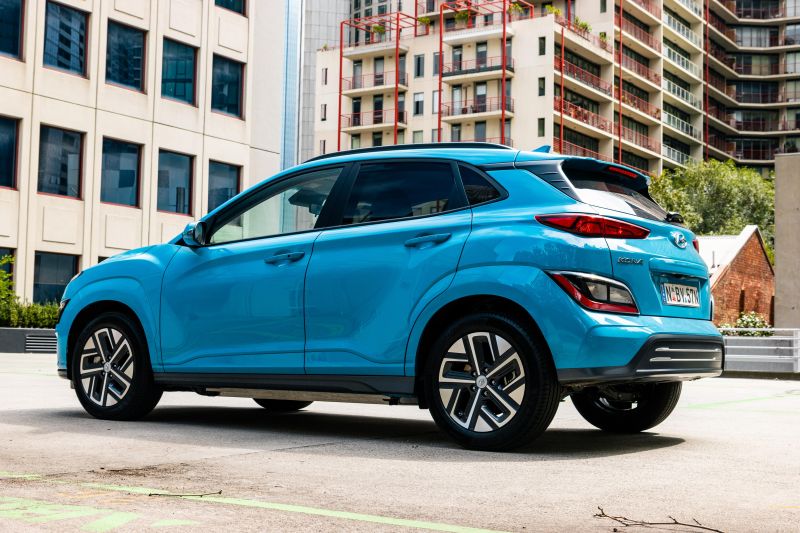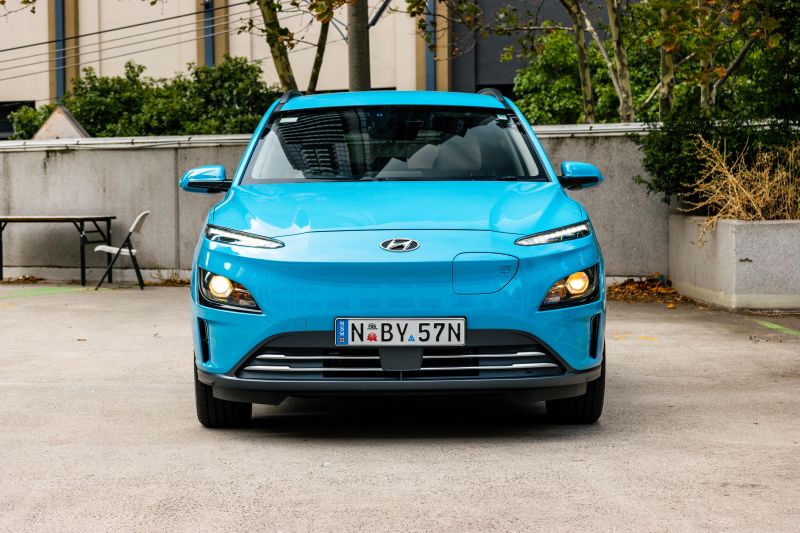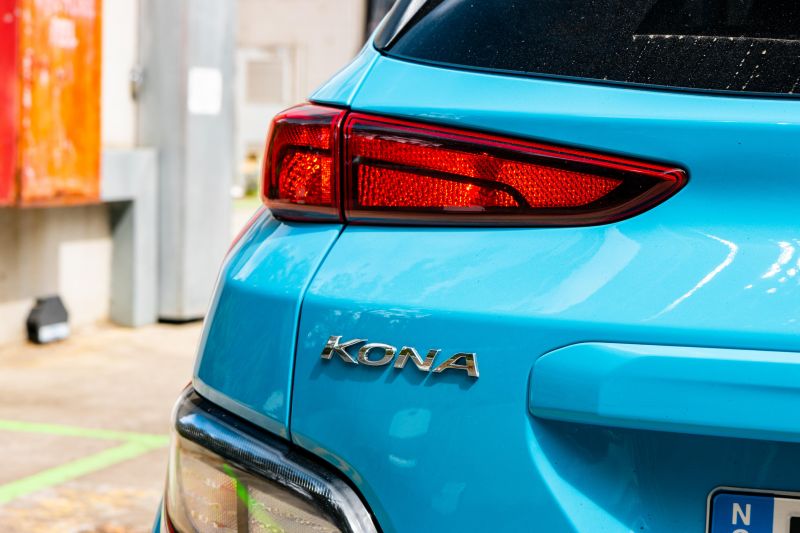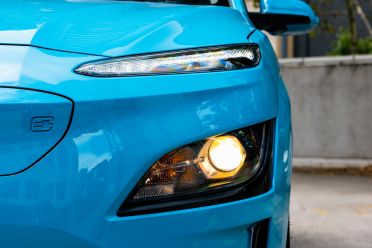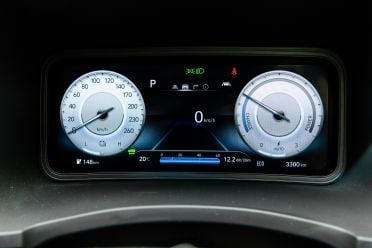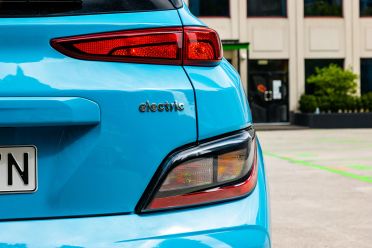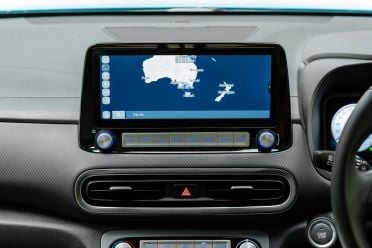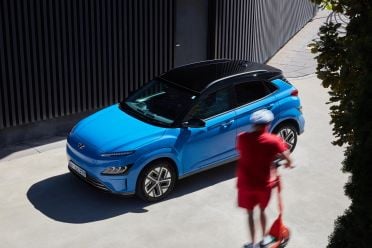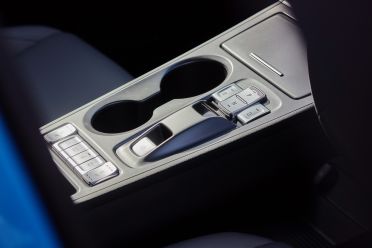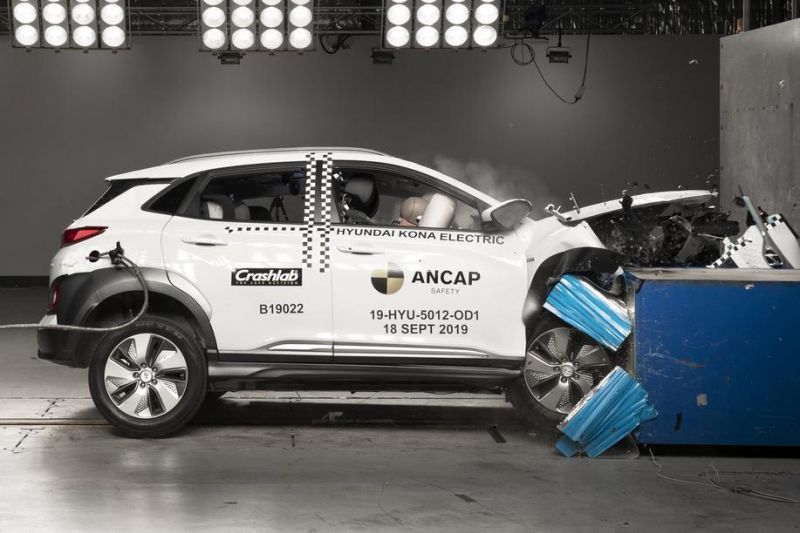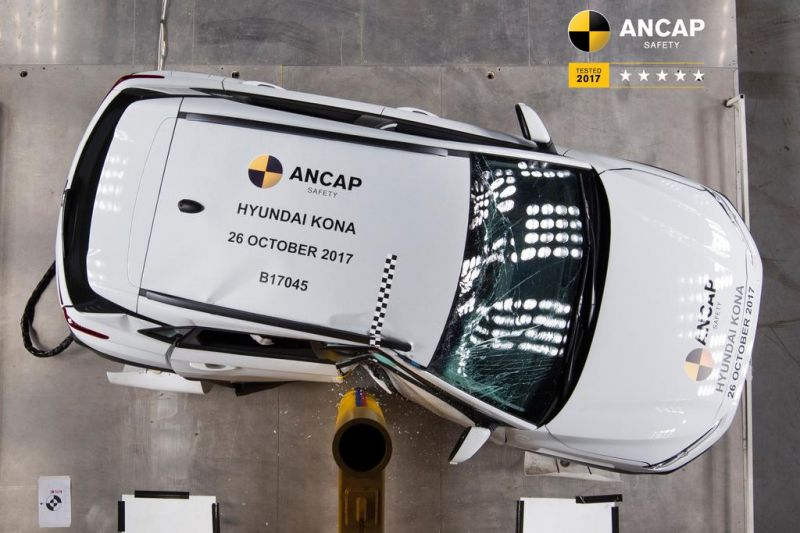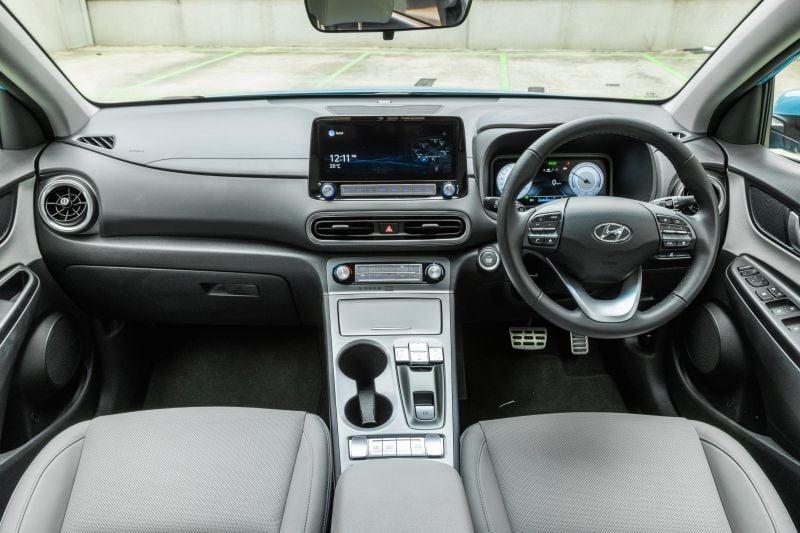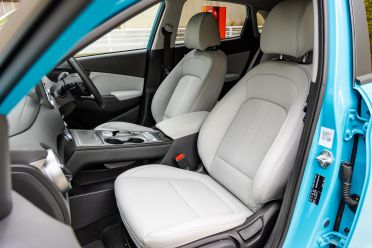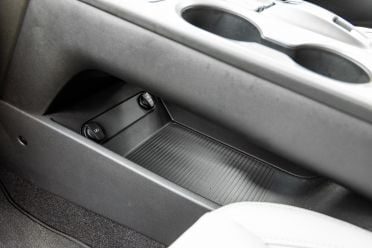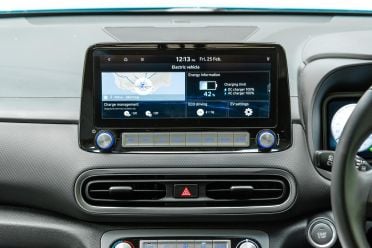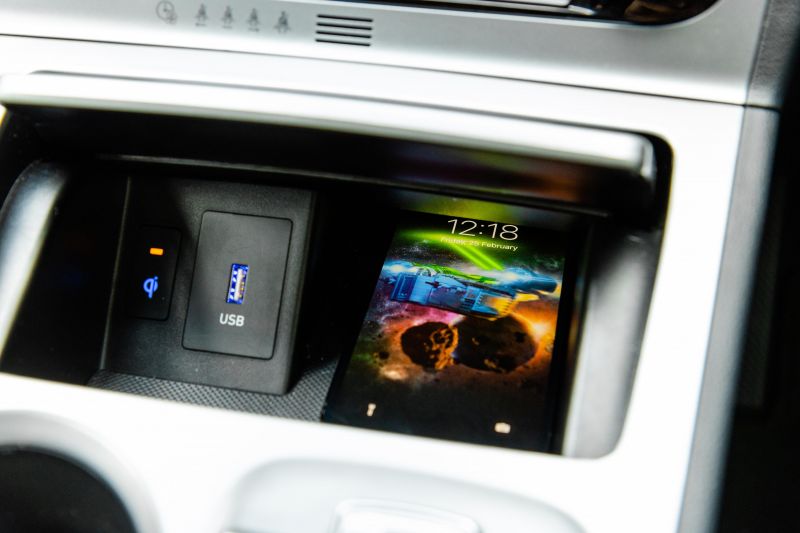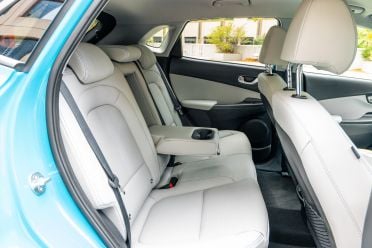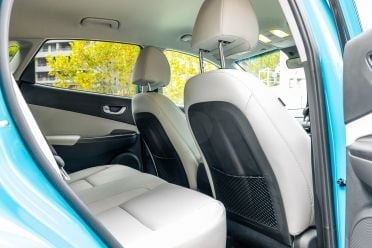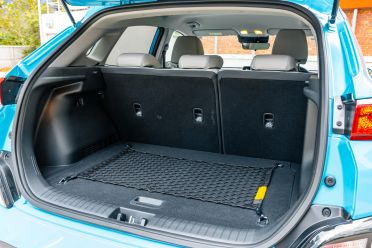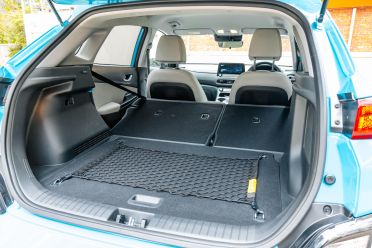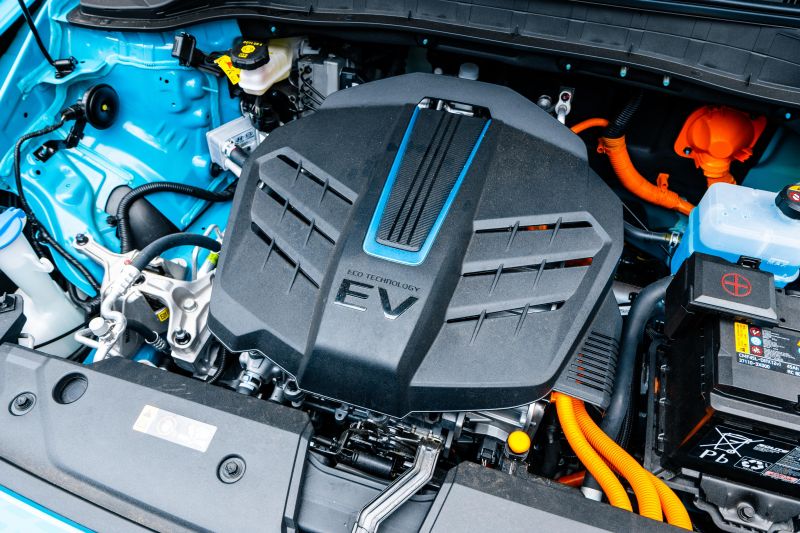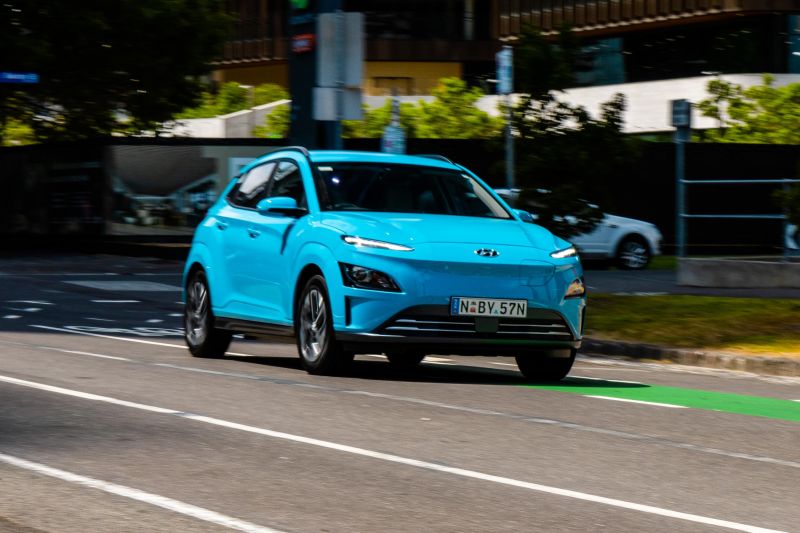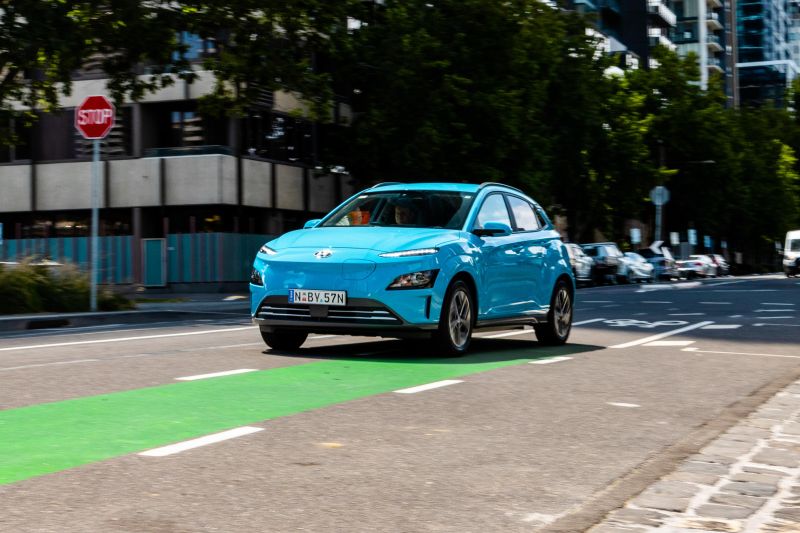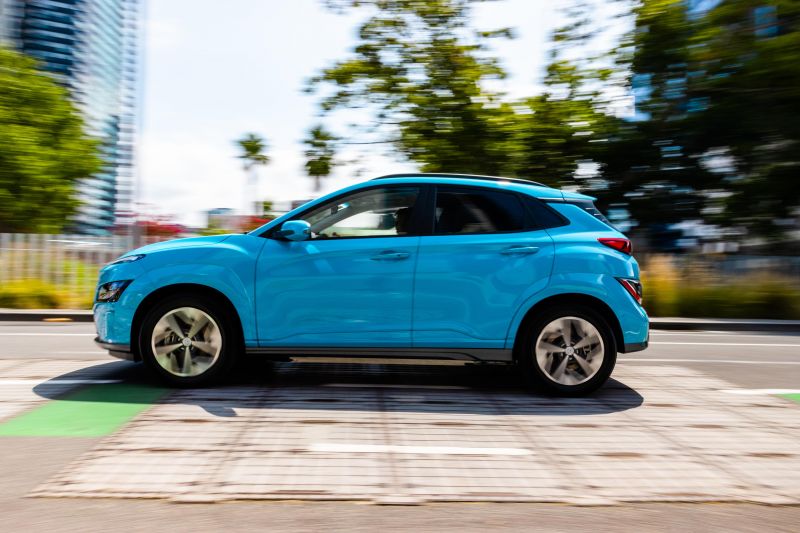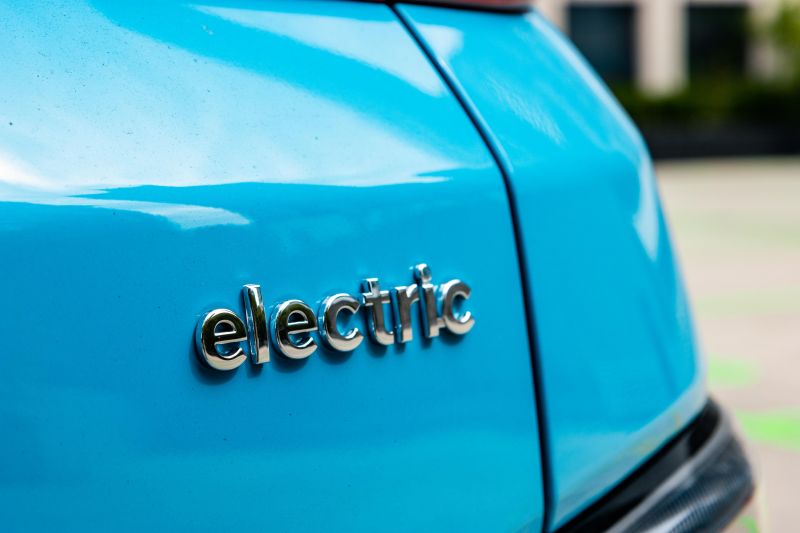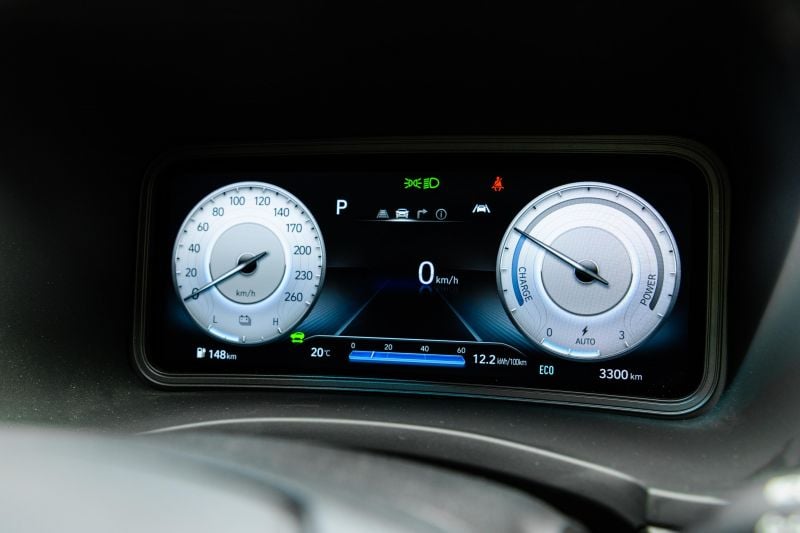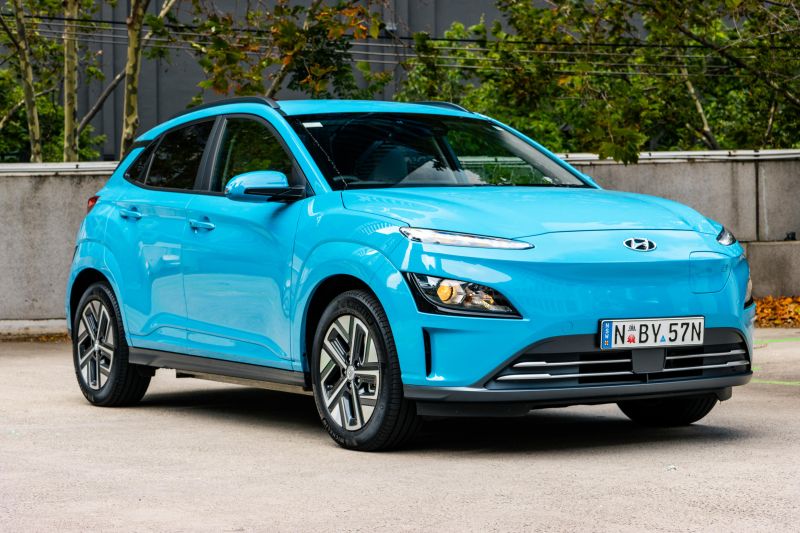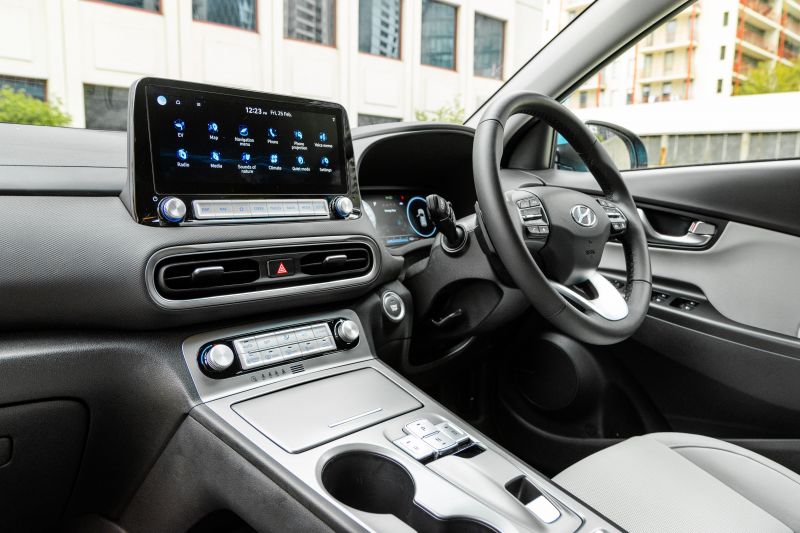The Hyundai Kona Electric was one of the first mainstream electric vehicles to really kick off in Australia, and enjoyed solid sales before the Tesla Model 3 made it to market.
It’s the third best-selling EV in Australia behind the Model 3 and Mercedes-Benz EQA, with 304 units registered to the end of the first quarter (to April 30).
Last year Hyundai essentially doubled the range in Australia by bringing in two versions of the more affordable Standard Range electric Kona, dropping the price of entry by a significant $7500 in the process.
That new entry point is the car we’re testing here – the 2022 Hyundai Kona Electric Elite Standard Range.
Priced from $54,500 before on-road costs, the cheapest Kona Electric on sale in Australia offers the same creature comforts as the existing Elite Extended Range version, albeit with a smaller 39.2kWh lithium-ion battery offering a 305km of range (versus 484km). The front-mounted electric motor has 100kW of power instead of 150kW.
The base Kona Electric is within striking difference of the MG ZS EV (from $46,990 drive-away) and Nissan Leaf (from $50,990), while offering similar range than both – the updated ZS EV claims 320km and the Leaf 270km.
So, is the little Hyundai the pick of the affordable EV offerings, or does it serve as a price-leader to get people into showrooms and upsell to higher-spec grades?

How much does the Hyundai Kona Electric Elite Standard Range cost?
We have the absolute entry point to the line-up: the Kona Electric Elite Standard Range, priced from $54,500 before on-roads.
That works out to just under $60,000 drive-away using a Melbourne postcode before incentives, and makes the Kona eligible for rebates around Australia.
Our tester’s Surfy Blue exterior paint adds $595, and the optional grey leather-accented interior adds a further $295. As tested, the vehicle you see here is $55,390 before on-roads.
2022 Hyundai Kona Electric pricing:
- Hyundai Kona Electric Elite Standard Range: $54,500
- Hyundai Kona Electric Highlander Standard Range: $58,000
- Hyundai Kona Electric Elite Extended Range: $60,500
- Hyundai Kona Electric Highlander Extended Range: $64,000
Key rivals include:
- Kia Niro EV S: $62,590
- MG ZS EV Essence: $49,990 D/A
- Nissan Leaf: $50,990
All prices exclude on-road costs
What do you get?
Kona Electric Elite highlights:
- Dusk-sensing headlights (halogen projector-type)
- LED daytime running lights
- 17-inch alloys with Michelin Primacy 4 tyres
- Leather-appointed upholstery
- Keyless entry/start
- Climate control with auto defog
- Rain-sensing wipers
- Rear privacy glass
- 10.25-inch digital instrument cluster
- 10.25-inch infotainment system
- Satellite navigation
- Apple CarPlay/Android Auto (wired)
- 8-speaker Harman Kardon audio system
- Heated/power-folding side mirrors
- Reversing camera
- Rear parking sensors
- Hyundai SmartSense
Kona Electric Highlander adds:
- LED headlights
- LED tail lights
- High Beam Assist (auto high-beam)
- Front parking sensors
- Head-up display
- Powered glass sunroof
- Heated/ventilated front seats
- Heated rear outboard seats
- Power front seat adjustment
- Electrochromatic rear-view mirror
- Heated steering wheel
- Ambient interior lighting
- Two-tone roof option (deletes sunroof)
Is the Hyundai Kona Electric Elite Standard Range safe?
The Kona Electric carries over the combustion-engined model’s five-star ANCAP safety rating achieved in 2017.
Using older test criteria, the EV managed a frontal offset audit score of 14.97 out of 16.00 – slightly better than the petrol model’s 14.07/16.00 – while the 16.00/16.00 score for the side impact test and 2.00/2.00 for the pole test were carried over from the petrol version.
Whiplash protection was rated Good, pedestrian protection deemed Acceptable, and the overall score for the entire Kona line-up is 35.07 out of 37.00.
By comparison, Euro NCAP tested the Kona in 2017 using a similar system to that used today, with the crossover managing 87 per cent for adult occupant protection, 85 per cent for child occupant protection, 62 per cent for pedestrians and 60 per cent for safety assist.
However, the Euro NCAP rating doesn’t apply to electric models.
Standard safety equipment includes:
- Autonomous emergency braking (AEB)
- Pedestrian and cyclist detection
- Adaptive cruise control with stop/go
- Driver attention monitoring
- Lane-keep assist
- Lane Following Assist (active centring)
- Blind-spot assist
- Rear cross-traffic assist
- Driver attention warning
- Rear occupant alert
- Safe Exit Warning
- Reversing camera
- 6 x airbags
What is the Hyundai Kona Electric Elite Standard Range like on the inside?
Anyone who has sat in a current-generation Kona won’t be in for any real surprises.
There are unique elements to the Electric, namely the unique centre console design incorporating a shift-by-wire gear selector and a cubby underneath – like a baby version of the larger Santa Fe and Palisade’s design.
Our test car’s optional grey interior lightens the mood a little, adding pale upholstery as well as grey plastic trim lower down in the cabin, and grey leatherette inserts in the doors. Standard black is also available and will save you $295.
Part of the mid-life refresh was upgraded displays. Across the Kona Electric range the twin 10.25-inch screens – one for the driver’s cluster, the other for the infotainment – is standard.
They’re welcome inclusions that improve the ambience of the Elite-badged Kona Electric, and fit the futuristic vibe well.
As we’ve found in previous reviews, the interface powering the infotainment system looks and feels slick, and offers the bulk of features you’d expect – embedded satellite navigation, wired Apple CarPlay and Android Auto, as well as DAB digital radio.
Graphics are crisp, response times are quick, and you’re not really left wanting other than perhaps for wireless smartphone mirroring, which continues to be a minor gripe with high-grade Hyundai and Kia systems.
The Kona feels like a compact car up front but there’s enough adjustment in the front seats and steering wheel to find a good driving position even if you’re tall-ish like me (at 6’1), and the cabin isn’t so skinny that you’re rubbing shoulders with the person next to you.
Storage isn’t too bad for such a little car, with a drawer ahead of the e-shifter housing a wireless phone charger and USB-A port, two cupholders in the centre console, a cubby under the front-centre armrest, the shelf underneath the centre console with 12V power, as well as bottle holders in the doors.
The glovebox is also a decent size, and there’s also a roof-mounted sunglasses holder.
Material quality is a bit of a let down. While everything feels well screwed together, the normal Kona’s plasticky trims for the dashboard and doors remain. It’s arguably more acceptable in the $54,500 Elite Standard Range than it is in the $64,000 Highlander Extended Range, however.
Like the petrol-powered Kona, the electric model doesn’t have the most accommodating second row. In fact, this is more of a 2+2 seater if you’re karting adults, though kids should be just fine.
Knee and legroom are pretty tight, particularly behind a taller driver, and toe room is fairly limited given the battery pack requires the floor to be lifted somewhat.
There’s a fold-down armrest with cupholders and bottle holders in the doors, though, and there’s also a USB charge point at the rear of the centre console. Netted map pockets feature behind both front seats, too.
ISOFIX anchors on the outboard seats and top-tether points for all three positions round out the second-row specs.
Further back again there’s 332L of boot space with the rear seats in use, expanding to 1114L with them folded.
By comparison, the regular Kona offers 374 litres with five seats in use, and 1156L with the second row folded.
While there’s reduced capacity compared to its combustion-powered equivalents, the Kona Electric does come standard with a luggage net that mounts on four chrome rings, and there’s a bag hook and cargo shelf.
Oddly, there’s no power outlet in the rear, and there’s also no spare wheel – a tyre repair kit is fitted.
What’s under the bonnet?
Being based on a combustion-powered platform, the Kona is packaged as such – there’s no frunk here like you might find in a Tesla.
The Kona Electric Standard Range features a 100kW/395Nm electric motor on the front axle, fed by a 39.2kWh lithium-ion battery pack.
Hyundai claims the entry-level drivetrain offers up to 305 kilometres of range (WLTP) per charge, and supports 50kW DC charging rather than the 100kW maximum of the Extended Range models.
At 50kW, the battery can be replenished from 10-80 per cent in around 64 minutes. Using a 7.2kW AC charger, it’ll take about 6 hours to charge from 10 to 100 per cent.
The Kona Electric Standard Range claims an energy efficiency rate of 14.3kWh/100km. By comparison, the Extended Range versions use a claimed 14.7kWh/100km.
How does the Hyundai Kona Electric Elite Standard Range drive?
Having spent a bit of time in the related Kia Niro EV recently, as well as multiple electric Konas in the past, the Kona Electric feels quite familiar.
The less powerful electric motor in Standard Range models still has nearly 400Nm of torque from rest, so it’s an effortless car to punt around town in and gets up to freeway speeds just fine.
I was actually quite impressed with how relaxed and well-sorted the base Kona Electric feels, and it packs all the grunt most people are ever going to need… though I know buyers with a need for speed will want Tesla performance.
Hyundai Australia doesn’t quote an official 0-100km/h time for the Kona Electric, but according to UK specs the 39.2kWh model with 100kW e-motor completes the benchmark sprint in 9.9 seconds, or 2.0 seconds slower than the 64kWh version.
As is the case with Hyundai and Kia’s electric vehicles, you get a constant UFO-like whirring sound as the car rolls regardless of the speed, and it may be polarising for some. I think it’s cute and futuristic for what it’s worth.
Being more compact that the mechanically-related Kia Niro, the Kona Electric looks and drives much more like a city-sized hatchback than a large car or an SUV, though that’s not to say it ever feels nervous or unstable.
In town or on the highway, the Kona Electric feels planted and secure, but its budget-friendly origins are felt in when it comes to on-road refinement. Road and wind noise get quite echoey, particularly on rougher blacktop.
That said, having the full suite of Hyundai Smart Sense safety features means you have adaptive cruise and active lane centring (Lane Following Assist) to allow for essentially Level 2 autonomous driving on the motorway, if you ever need to take an extended trip away from the Big Smoke.
Meanwhile, the Kona’s ride is on the firmer side of things, no doubt courtesy of the big, heavy battery pack mounted in the floor as well as the Kona’s more driver-oriented pitch in standard guise. It’s rarely terse over bumps, but it can feel a little firm over imperfections – though this is more resolved at higher speeds.
It’s worth noting also, the Kona Electric Standard Range is about 150kg lighter than the Extended Range with its larger battery, which translates to a slightly more light-footed over undulations and when things get a little twisty.
The steering is accurate, direct, and well weighted for a more dynamic feel. Given it’s fairly lithe for an EV (1535kg at its lightest), the front-drive layout and hatch-like proportions make the Kona Electric feel like a punchy hatchback. With a taut body and limited roll in corners, the Kona is a pretty fun thing to send through a windy pass.
One thing to note is the regenerative braking. You can adjust the intensity via the steering-mounted paddles and even put it in Auto which will vary the level of resistance using the vehicle’s sensors – e.g. more regen if the vehicle ahead is slowing down, or less when you’re just coasting.
Unfortunately, there’s no e-Pedal mode like you get in then Ioniq 5, meaning the Kona won’t come to a complete stop using regen alone. It’s still a pretty easy function to get your head around, and the car creeps at low speeds like you would expect from a petrol car.
How much does the Hyundai Kona Electric Elite Standard Range cost to run?
Hyundai Australia covers the Kona Electric line-up with a five-year, unlimited-kilometre new car warranty and an eight-year, 160,000km battery warranty.
There’s also lifetime capped-price servicing, with maintenance required at 12-month, 15,000-kilometre intervals.
Buyers can opt for pre-paid servicing plans, with three-, four- and five-year packages available. They are advertised for $540, $1205 and $1385 respectively.
That’s a fair chunk less than the related Kia Niro EV, which in standard 64kWh guise costs for $1164 and $1728 for its three- and five-year service plans respectively.
In terms of real-world efficiency, we were very impressed with the Kona’s energy consumption. Hyundai officially quotes 14.3kWh/100km on the combined cycle, but we regularly saw it dip into the 13s according to the trip computer.
Hyundai’s range claim of 305km seems easily doable, and with more driving in town you’d likely see more. I hooked it up to a Chargefox 50kW fast charger and got 18.47kWh back in the battery within 28 minutes, which is just under half charge within half an hour.
CarExpert’s Take on the Hyundai Kona Electric Elite Standard Range
The Kona Electric’s base pricing may not be quite as sharp as an MG ZS EV or a Nissan Leaf, but it counters by being a more resolved package as well as offering impressive real-world efficiency.
Anyone recent Hyundai or Kia owners won’t be diving through service manuals or YouTube tutorials to use the in-car features, and even in Elite spec this Kona Electric Standard Range offers infotainment and safety assist features befitting the price – perhaps with the exception of halogen projector headlights.
However issues carried over from the petrol-powered donor car remain. The Kona is small inside and out, meaning this $54,500 vehicle will be a tight squeeze if you have teenagers or adults that you drive around regularly – something that is less of an issue in the MG ZS EV, the Nissan Leaf, as well as the Kia Niro.
Further, if you look the better-specced Highlander trim ($58,000) there’s swathes of extra desirable kit but then the Kona isn’t as competitive against similarly-priced competitors offering more space, range, and performance.
If you’re looking for a budget-friendly electric vehicle that doesn’t look or feel like a spaceship, the base Kona could be worth a look.
However, the new MG ZS EV with its larger 51kWh battery claims 320km of range per charge and starts over $10,000 cheaper – whether the Hyundai is worth the premium will be up to you.
Click the images for the full gallery
MORE: Everything Hyundai Kona





